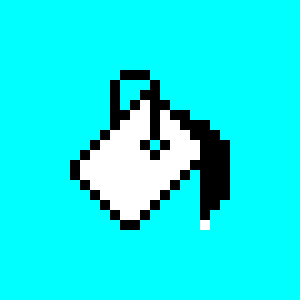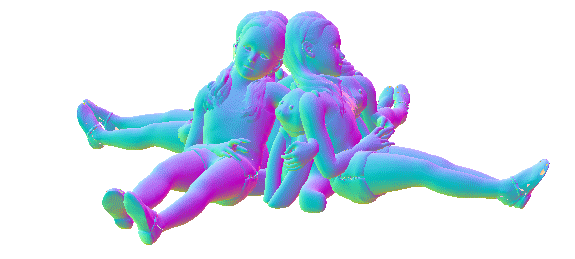Art & Exhibitions
Iranian GIF Exhibition Brings Out the Medium’s Sharpest and Silliest
Few of the animated artworks have anything to do with Iran, or even politics.

Courtesy the artist, via "GIFbites."
Few of the animated artworks have anything to do with Iran, or even politics.

by
Paddy Johnson


What does data sound like? There are probably thousands of answers to this question, but whatever the case, most of us can think of a few sounds conventionally used to approximate the idea: static, the sound of a modem connecting to the Internet, metal stretching and warping.
I heard some version of all these sounds when perusing “GIFbites,” an online exhibition pairing animated GIFs with audio files that is predictable and cliché-ridden, but also strikingly brilliant. With over 50 artists curated by Daniel Rourke, “GIFbites”is an online component of the larger brick-and-mortar showcase of digital art “Bitrates,” currently on view at the Dar-ol-Hokoomeh Project in Shiraz, Iran, and curated by Morehshin Allahyari and Mani Nilchiani. The physical portion of the show runs through June 6.
The online portion of the exhibition strings together 53 GIFs in a continuous loop, with 45 seconds allotted to each piece. All in all, the show runs a little over 30 minutes, though there’s no expectation that users will see it all in one full rotation. I saw the entire show in one sitting. All but one GIF is tiled.
Rourke describes the show as an homage to brevity and the potential of poor images to speak beyond their bitrates (the computer processing time for a basic unit of information in computing). Basically, the show is an invitation to say as much as humanly possible with a GIF, a sound file, and the 45 seconds the exhibition loop allots to each project.
Given that directive and the host venue’s Iranian location, you’d expect to see more politically-minded work in the show. For the most part, the context of the show insinuates a politicized interpretation where one might not otherwise exist. Take Sid Branca’s #1 Hit, which pairs a slowed-down snippet of Britney Spear’s “Hit Me Baby One More Time” with a GIF of Spears and Branca singing together. To me, this looked like a possible allusion to the self-destructive nuclear program that has led the US to impose sanctions on Iran, but that could just be a projection. I also read that into Lorna Mills’s GIF of a snake eating itself while slithering over an image of Earth, which seems unlikely given that this is done to the beat of Latin Boogaloo. Also, this is an artist who is known for blinging unicorns and animating claw tits.

Campanology, by Elixirix, may contain the show’s most compelling commentary on contemporary Iran. The artist has chosen a GIF of a group of men ringing bells. Historically, when there was a fire, the bell ringer ran to the church to call people to action. The accompanying audio alludes to the dangers of the job then and now. “In the Middle Ages, it was believed that the sounds of the bell could disperse thunder,” a man’s voice explains. “In France, between the years 1753 and 1786, 103 bell ringers were killed during thunderstorms as a result of holding onto wet bell ropes.”
More work like this could have enriched the show. Many artists preferred, instead, to focus on the subject of the digital, a direction that generally disappoints. Many pieces do nothing more than dabble in technology-inspired abstraction without bringing anything new to the table. Shay Moradi’s Ocean’s Apart, a cube with shifting blue pixels and a static-y sound track, is a good example of this. Maybe there’s some comparison here between materiality and the digital—the bottom portion of the GIF seems to be replicating the texture of paint—but that’s a juxtaposition, not a statement. Antonio Roberts’s RIP Retinas suffers similarly. He’s paired a blinking multicolored GIF made of moving squares, number chains, and an accompanying audio file that sounds like chiptune number-crunching. The combination simply restates what we already know about digital technology.
These types of predictable audio-visual pairings don’t give a user much reason to continue browsing. Others fare even worse. Kim Asendorf and Ole Fach literally drove me off the page, with their piece combining a GIF of a black man eating White Castle with a euphoric audio clip of him drool-moaning. It mocks lowbrow culture while posing as a celebration of it, and seems intended to tickle an art audience dumbly. I refreshed the page to escape that offensive contribution. Sadly, short of a hard return in the URL window, there’s no way to skip forward through the exhibition loop in search of better work. That’s a design shortcoming of the show’s format, though I like that the randomizer is sophisticated enough to know not to repeat GIFs until all 53 in the exhibition have cycled through.
While uneven, the show has plenty of strong work. Jeremy Bailey, the self-described “Famous New Media Artist,” does a good job packing in meaning by pairing an animated GIF of himself levitating a bunch of colorful 3D shapes with a stripped-down electronic version of Joan Osborne’s “What if God Were One of Us?” Bailey has cast himself as God, and wants us to know he’s great. Very clever. Anthony Antonellis’s Photoshop Skills takes a different approach. Responding to the call for poor-quality images, the artist combines the simple graphics of Photoshop icons with the theme song for Picture Pages, an educational TV segment for preschoolers to reflect on making. Sam Meech’s strategy is similar, using frames from a knitted scarf paired with the sound of a mechanical crank. The piece brings attention to the lo-tech qualities of the GIF and predecessors like the zoetrope.

But of all the work in the show, Jennifer Chan’s Hands Around the World seems to be saying the most. The piece features an image of hands circling the Earth over a reflecting pool, matched with a midi file of the Spice Girls hit “2 Become 1.” On its face, the GIF is simply a literalization of the Spice Girl song title: an image associated with world peace iconography and ancient spiritual healing sites, replicated and reflected. At the same time, though, it is contrasting the new and the old, sameness and difference, and even how we see ourselves. As Chan tells it, our identity is built on shared stories, interests, and even clichés. And, unlike so many other artist in this show, who took a conventional approach to noise, technology, and abstraction, Chan began with something literal, and ended with a meaningful work of art.
“Bitrates” continues through June 6 at the Dar-ol-Hokoomeh Project in Shiraz, Iran. “GIFbites” can be viewed online here.